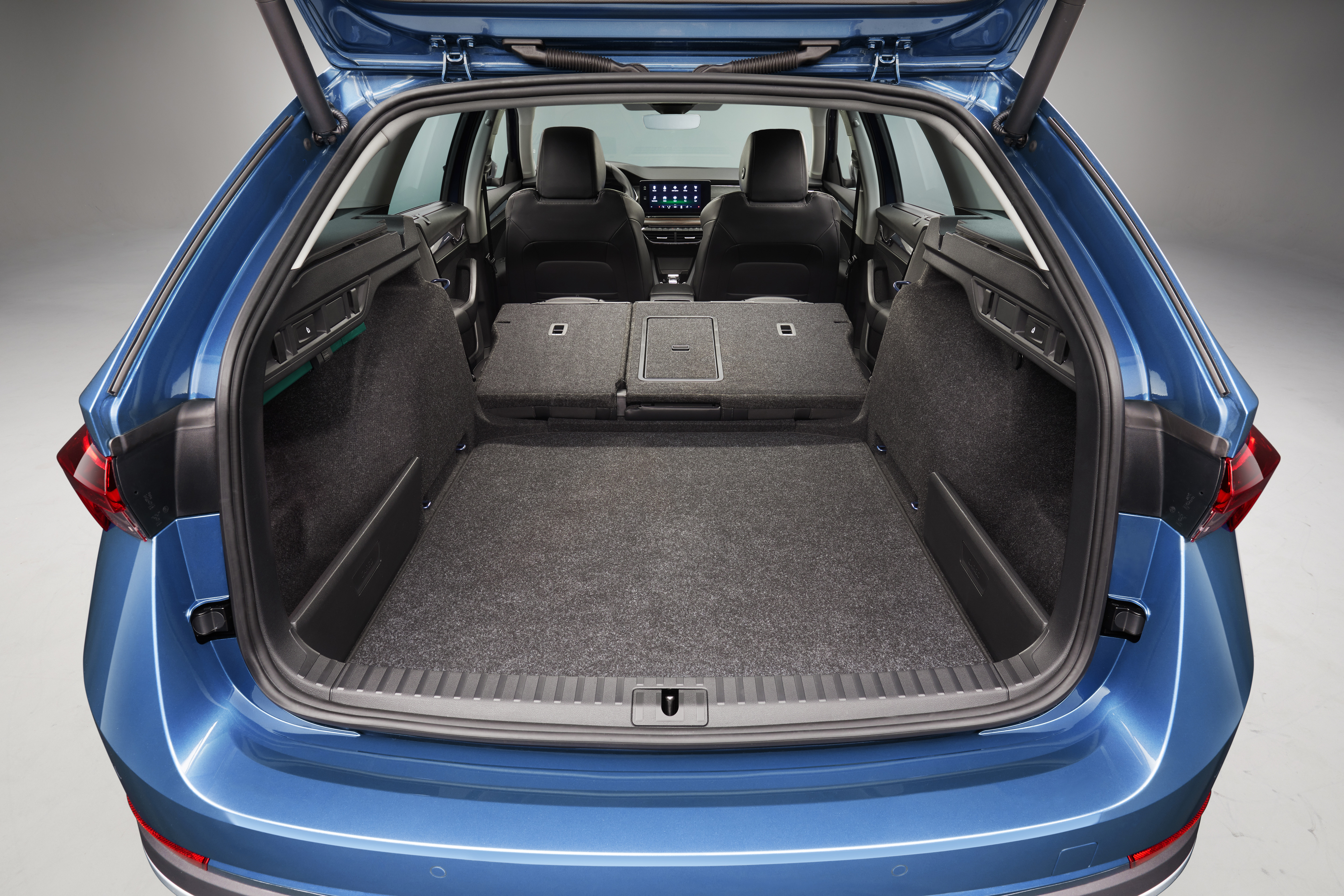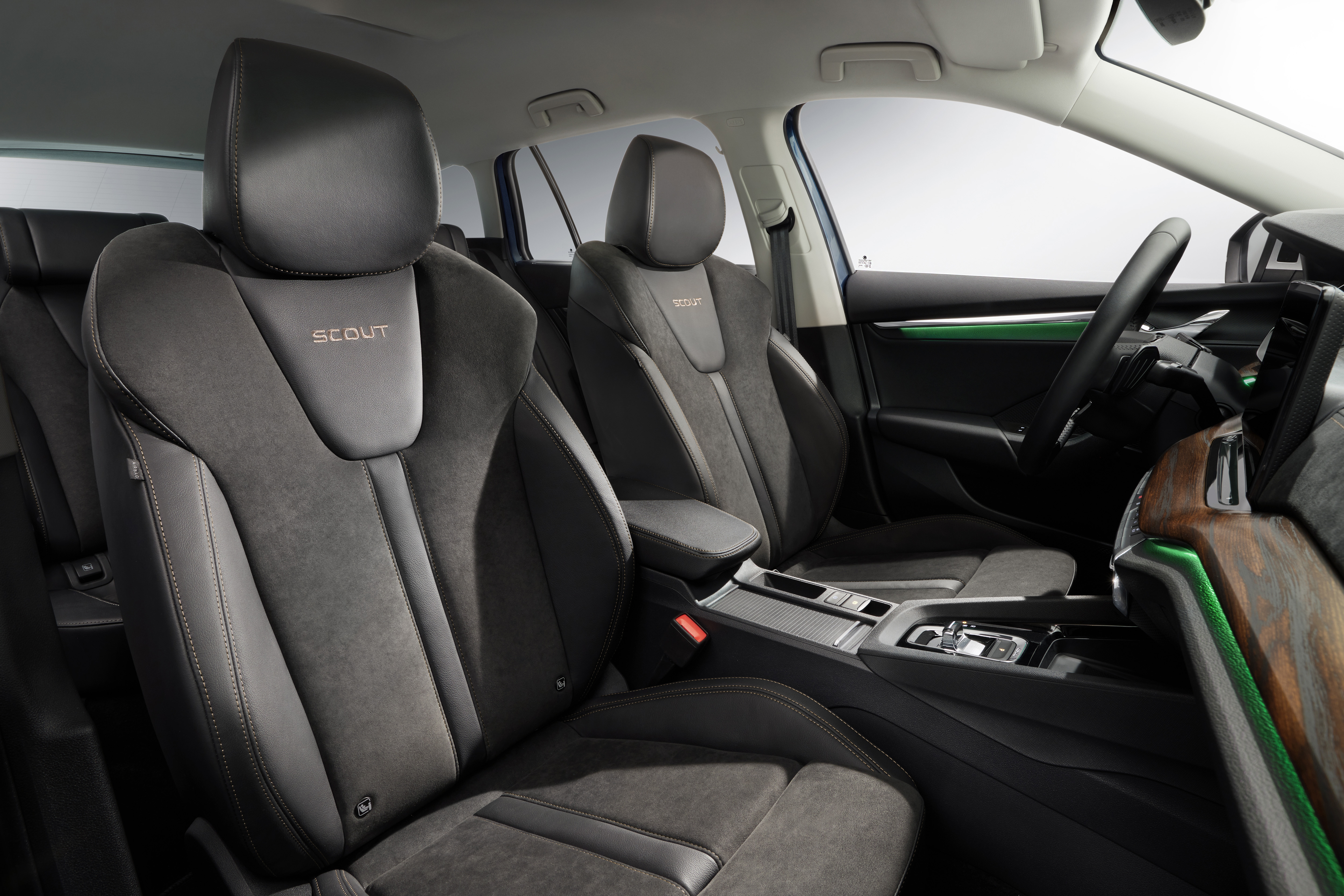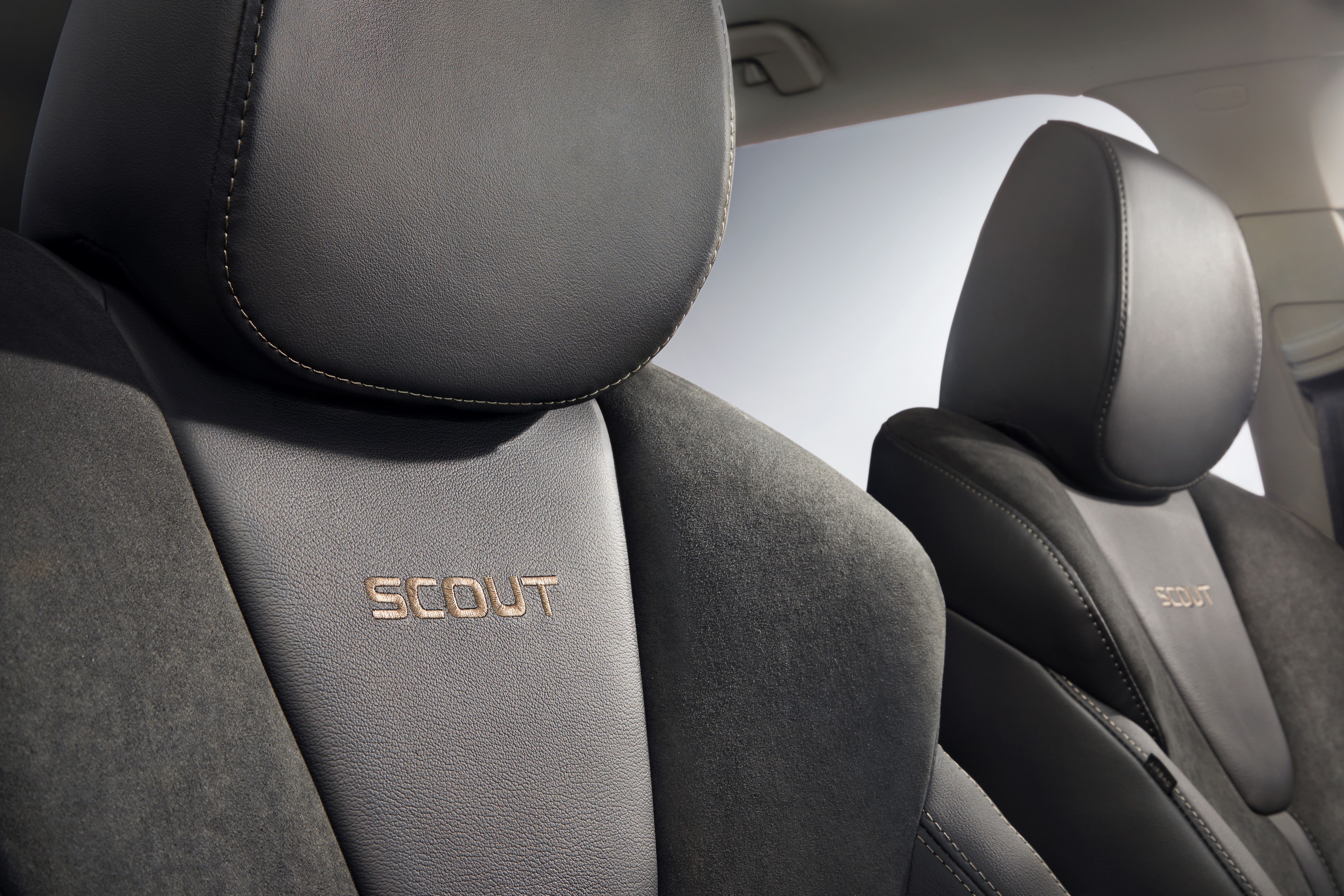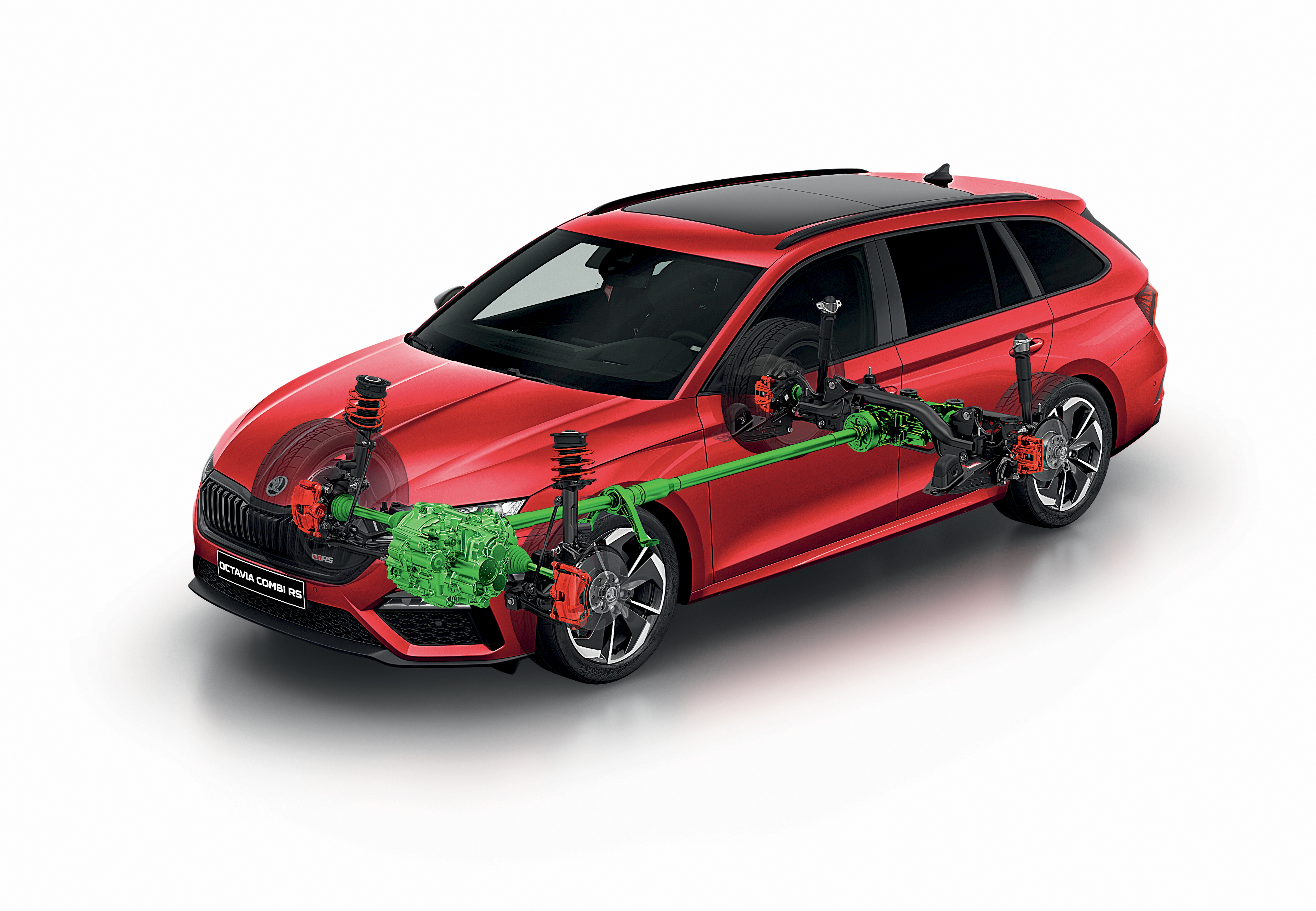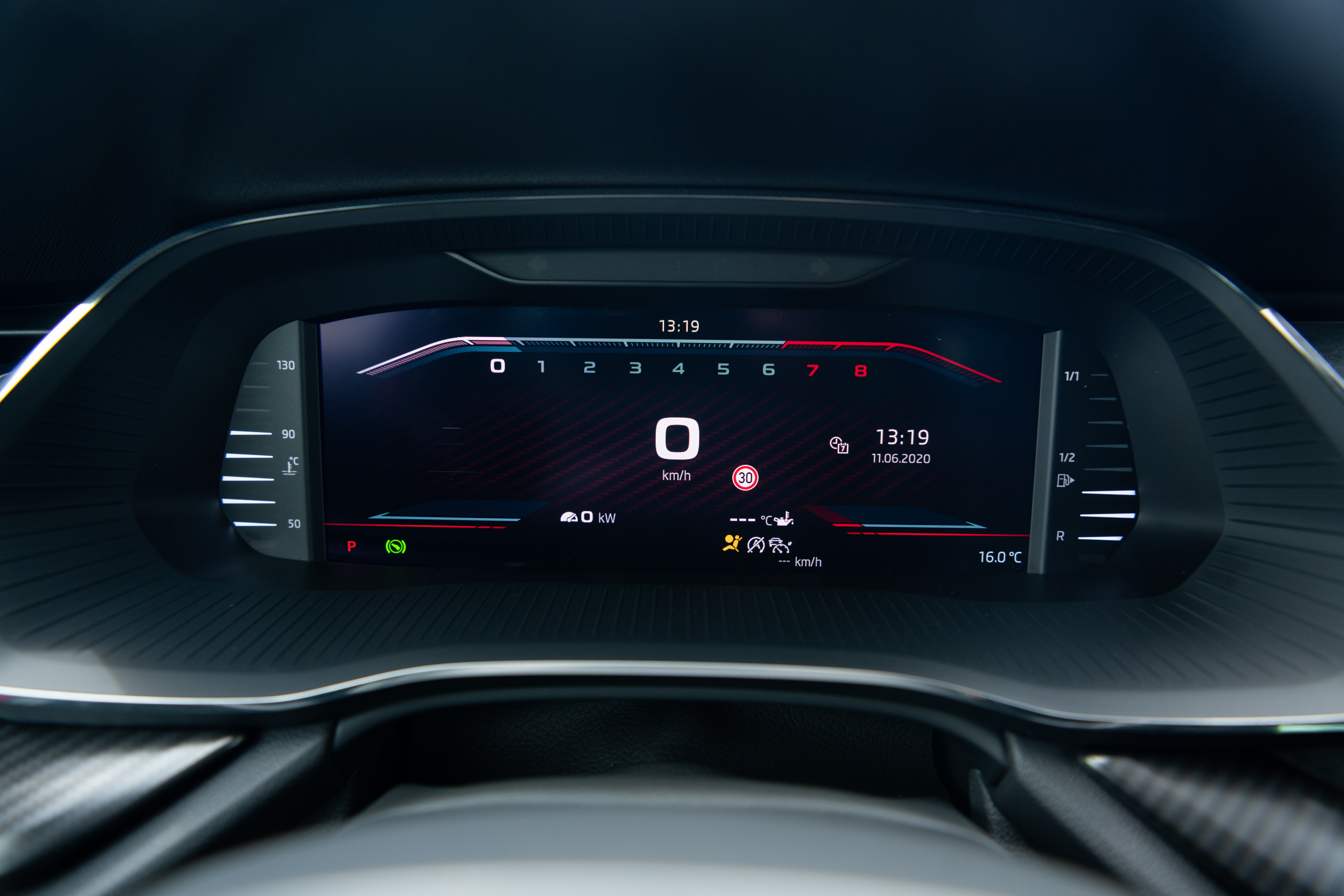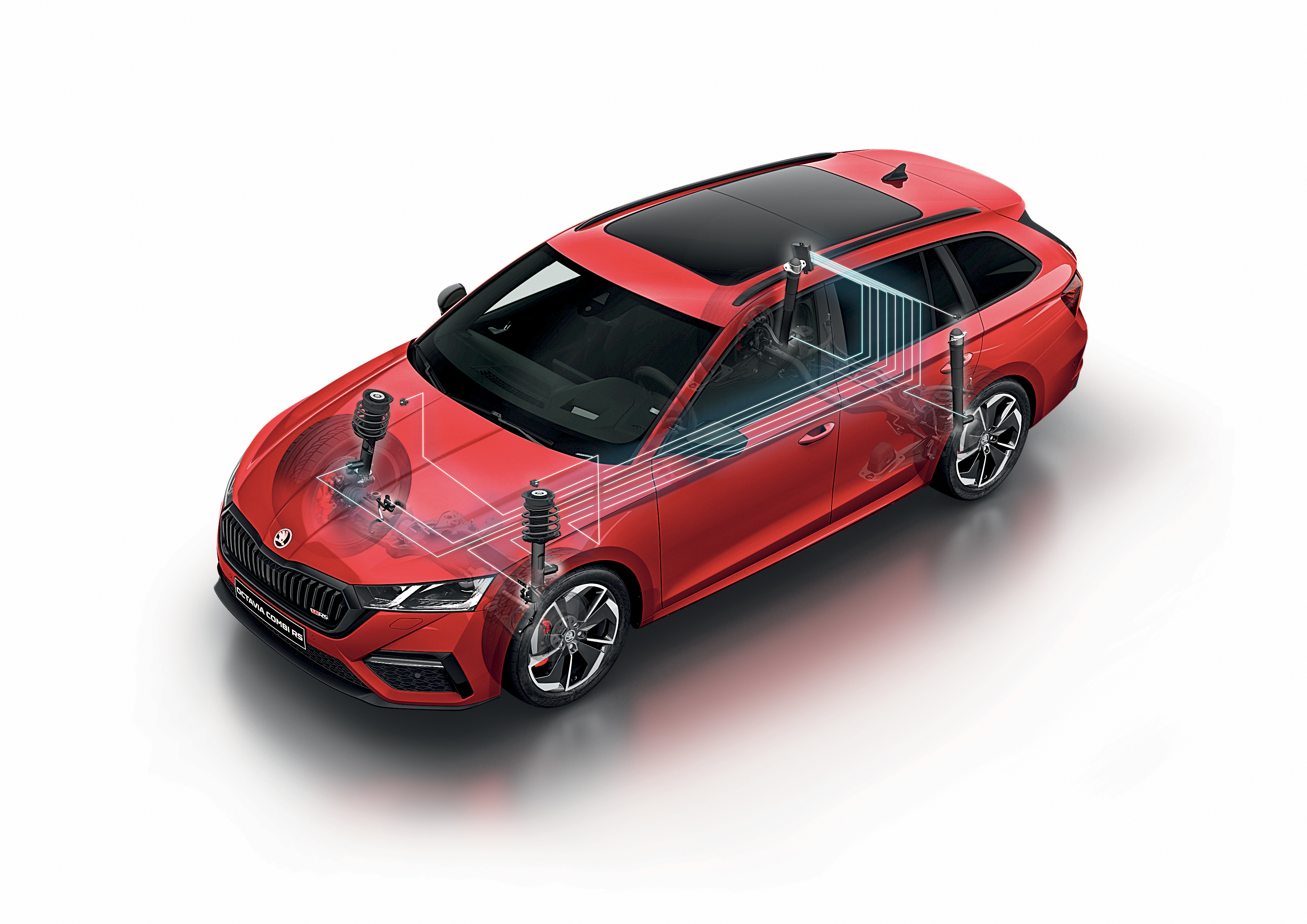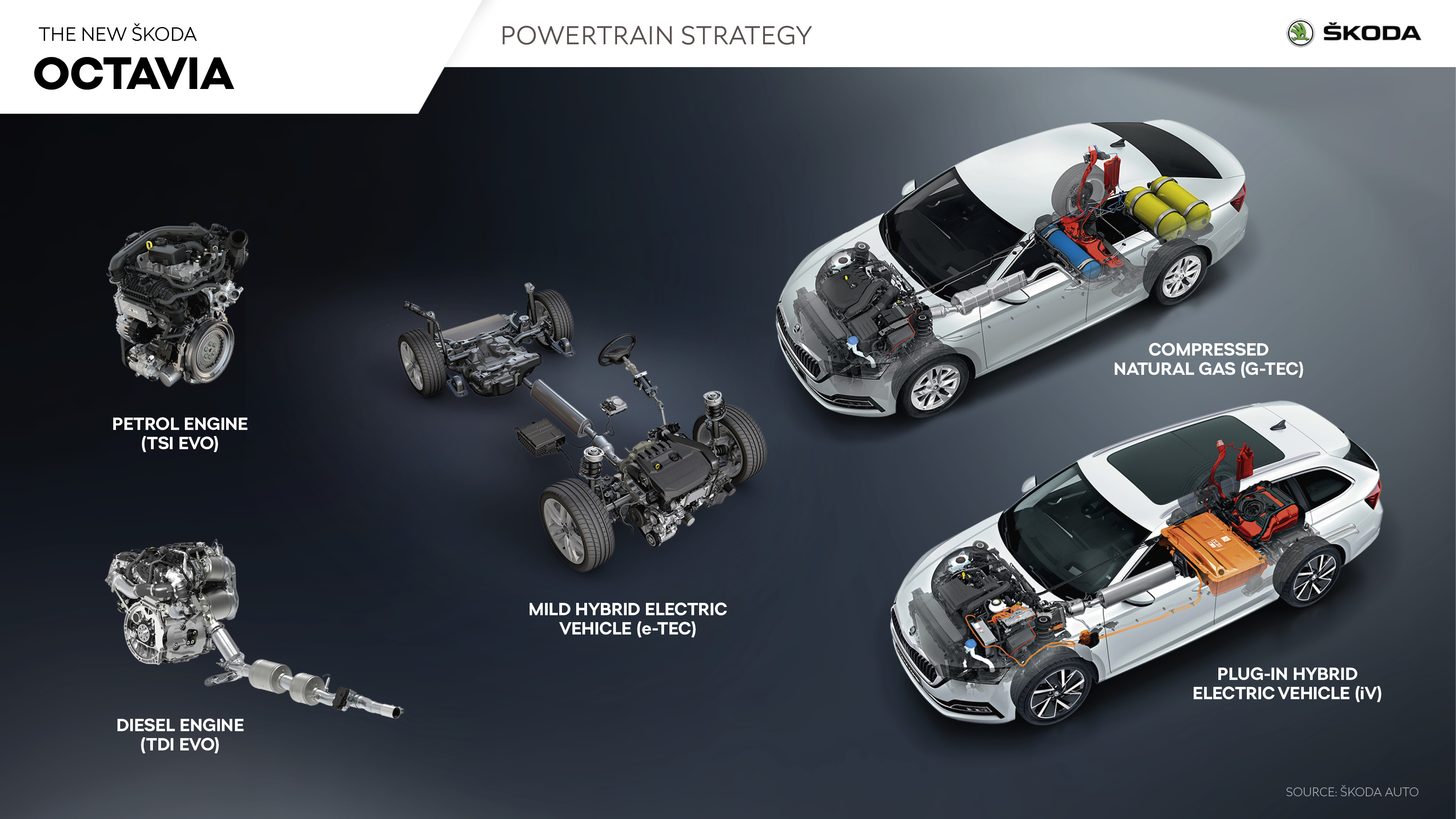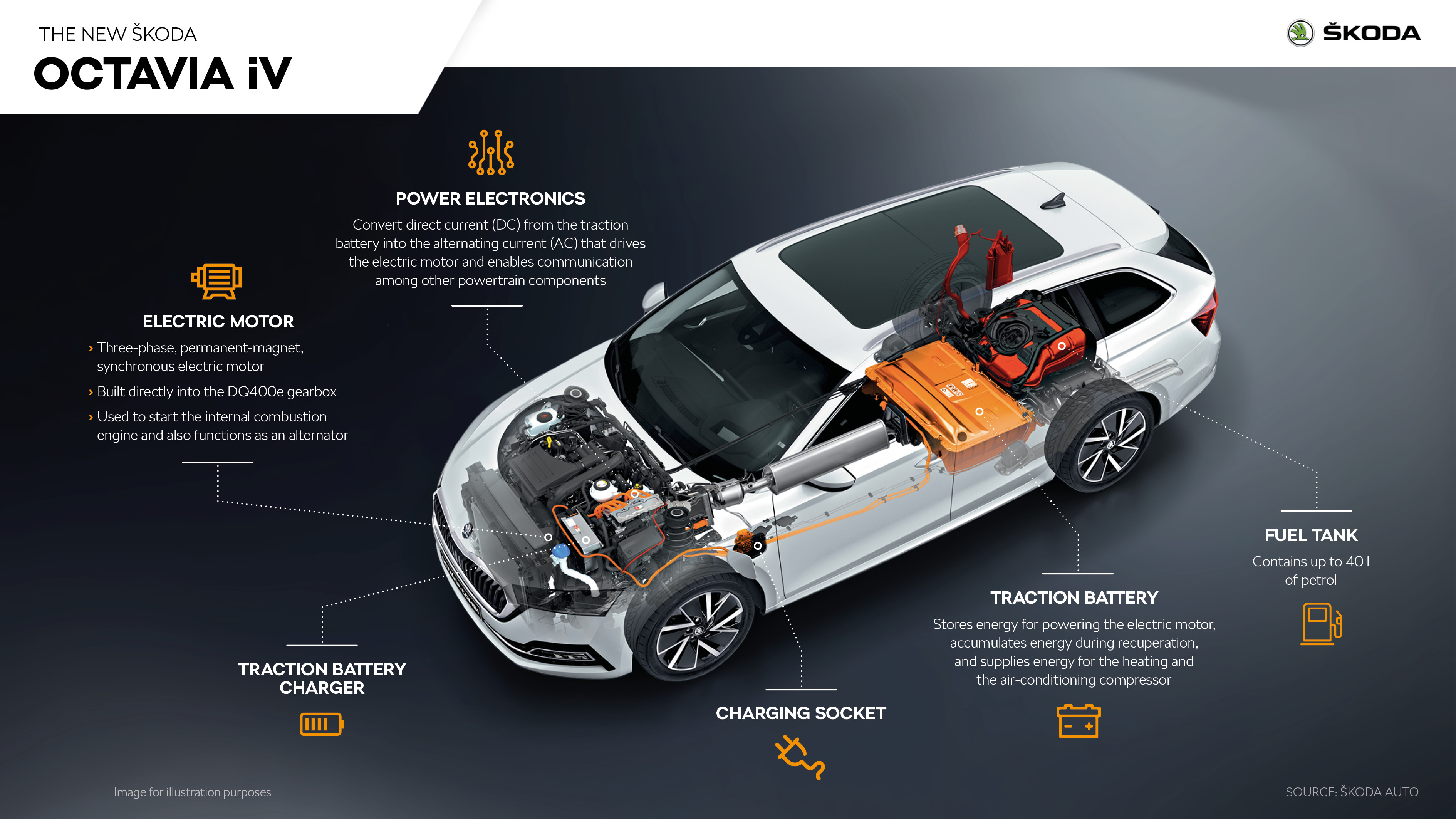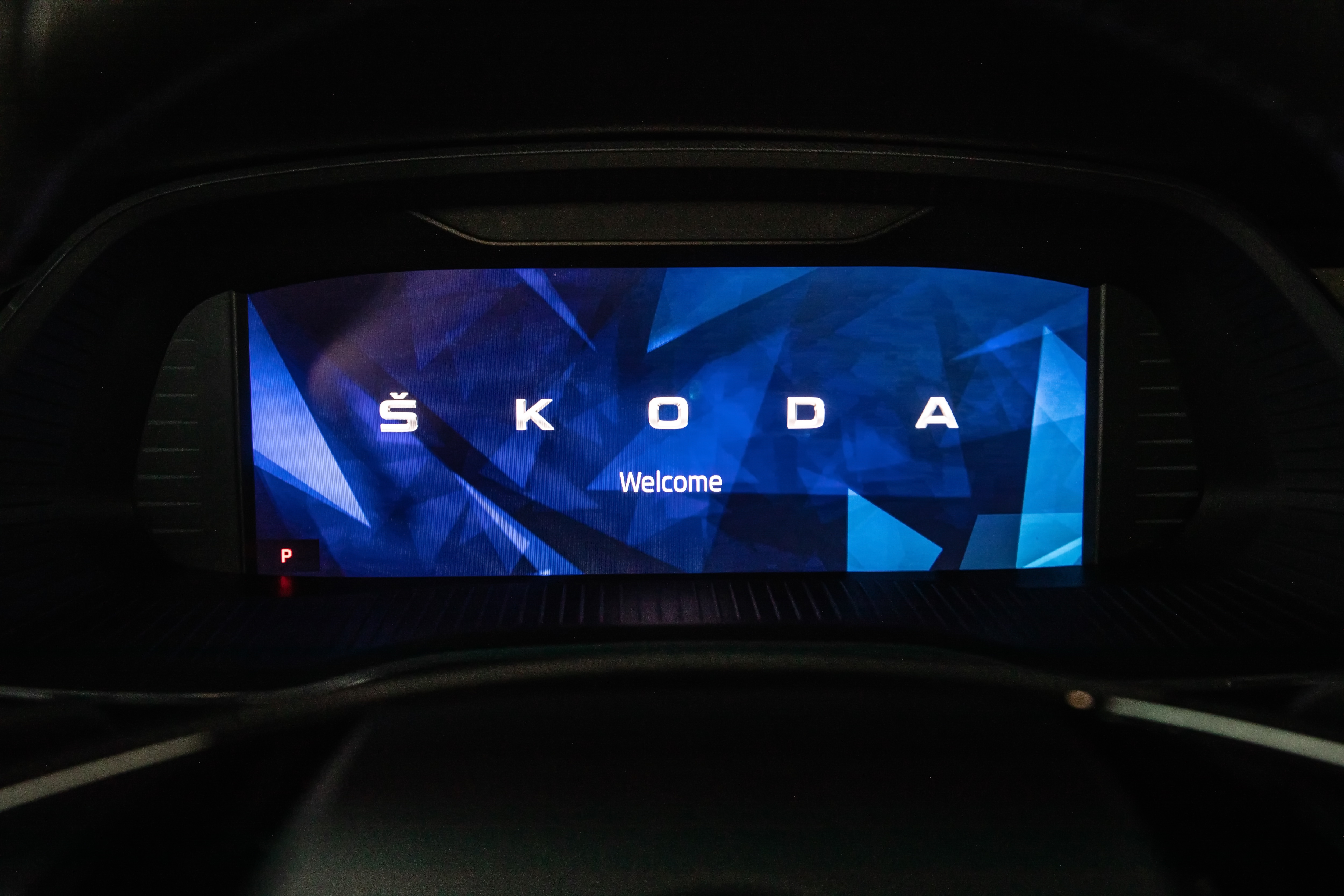The approximately 90-minute livestream will include a 30-minute vehicle presentation with statements from Bernhard Maier (ŠKODA AUTO CEO), Christian Strube (ŠKODA AUTO Board Member for Technical Development) and Oliver Stefani (Head of ŠKODA AUTO Design) as well as four technical workshops on the topics of the OCTAVIA RS, OCTAVIA SCOUT, drivetrain strategy and connectivity.
Mladá Boleslav, 3 July 2020 – The ŠKODA OCTAVIA is the heart of the Czech brand and tops the bestseller lists in numerous European countries. A rugged SCOUT and two further sporty RS variants have now been added to the fourth-generation OCTAVIA portfolio. By electrifying the powertrain with new mild hybrid technology and two OCTAVIA iV plug-in hybrids, ŠKODA has reduced the OCTAVIA’s CO2 emissions even further. The iV variants of the bestseller can travel up to 60 km in the WLTP cycle without producing any emissions; the combustion engines have also continuously been optimised. They are now even more efficient. Furthermore, ŠKODA has lowered nitrogen oxide emissions from the new EVO generation of diesel engines by about 80 per cent using the ‘twin dosing’ process. With a choice of two body variants, front- or all-wheel drive, manual or DSG transmission as well as five drive systems – petrol, diesel, CNG, mild hybrid and plug-in hybrid – every ŠKODA OCTAVIA customer will find their perfect match. The centrepiece of the OCTAVIA’s all-wheel drive system is a sixth-generation electronically controlled multi-plate clutch, which – among other things – is significantly lighter than its predecessor following a comprehensive technical update.
Bernhard Maier, ŠKODA AUTO CEO, said, “The new generation of the OCTAVIA is one of the most important model updates for ŠKODA this year and is a key part of what is currently the biggest product campaign in our company’s history. We have refined our icon’s core virtues even further and have also taken another major step forward in terms of design, connectivity and safety. I am convinced that we will win the hearts of our customers once again with this great overall package.”
The success story of the ŠKODA OCTAVIA began in 1959. As the brand’s eighth model since the Second World War and the eighth to feature ultra-modern independent suspension for all wheels, it was given a name meaning ‘the eighth’ in Latin, a name which has since become synonymous with the entire brand. Next came the first OCTAVIA COMBI estate variant in 1961, which was produced until 1971. A total of 360,000 OCTAVIAs were built, including more than 54,000 units of the OCTAVIA COMBI. The first generation of the modern-day edition made its debut in April 1996. The unmistakable hatchback with a large tailgate was followed in March 1998 by the even more spacious OCTAVIA COMBI, which was particularly successful in Europe. By November 2010, 970,000 hatchbacks and more than 470,000 COMBIs had been sold. In 2004, the second modern day generation was launched. Of this, 1.7 million hatchbacks and 870,000 estates had rolled off the assembly line by 2013. The third generation introduced in November 2012 was also a huge success – a total of more than 2.5 million customers had opted for this OCTAVIA by spring 2020. Since 1959, ŠKODA has produced more than seven million OCTAVIAs.
Bestseller in many markets and produced in five different countries
Up to 400,000 OCTAVIAs are now produced per year and it tops the list of bestsellers in numerous markets. The ŠKODA icon has already been the chart-topping vehicle in its homeland of the Czech Republic 30 times and it has also been listed at the top in seven other countries, including Poland, Austria, Switzerland and Finland. In Germany, the OCTAVIA’s second-largest sales market in the world, it has been the number-one import vehicle for many years. The OCTAVIA COMBI, which is the bestselling estate car in Europe, plays a major part in this. The chartbuster is the brand’s only vehicle to be produced in five different countries: in addition to the Czech Republic and China, it also rolls off the lines in Russia, Kazakhstan and India.
A successful big family
Just like in previous generations, the almost coupé-like hatchback, featuring a large tailgate, and the COMBI, now with an even larger boot (640 l), are key members of the fourth generation of the OCTAVIA family too. With a drag coefficient (cd) from 0.24 for the hatchback and 0.26 for the COMBI, both OCTAVIA body variants are amongst the most aerodynamic cars in the world in their respective segments. The OCTAVIA SCOUT is exclusively available as an estate, offering rugged body enhancements and a Rough-Road package with raised ground clearance as standard. The two OCTAVIA plug-in hybrids bear the abbreviation ‘iV’: the OCTAVIA iV has a total power output of 150 kW (204 PS) and the OCTAVIA RS iV delivers 180 kW (245 PS). Including the 180-kW (245 PS) 2.0 TSI and the 147-kW (200-PS) 2.0 TDI, there are now three powertrains available for the fourth generation of the sporty, top-of-the-range RS model. The two OCTAVIA variants with mild hybrid technology bear the e-TEC designation, while the OCTAVIA G-TEC is specifically designed to run on eco-friendly natural gas (CNG).
ŠKODA OCTAVIA SCOUT: Rugged estate with off-road styling
› New OCTAVIA generation in an off-road look continues SCOUT success story
› Multifunctional lifestyle estate with rugged details and 15 mm more ground clearance
› New OCTAVIA SCOUT boasts even more space and, for the first time, optional front-wheel drive
Mladá Boleslav, 3 July 2020 – The fourth generation of the ŠKODA OCTAVIA includes a new OCTAVIA SCOUT. The success story of this estate variant began in 2007 with rugged details, off road flair, increased ground clearance and all-wheel drive – and it is once again part of the ŠKODA bestseller’s line-up. In addition to its emotive design, the multifunctional lifestyle estate offers even more space than its predecessor and is now also available with front-wheel drive on request.
More videos can be found here.
Oliver Stefani, Head of Design at ŠKODA AUTO, explained, “The new OCTAVIA SCOUT perfectly combines elegance and ruggedness. It benefits from the more emotive lines and dynamic proportions of the latest OCTAVIA generation. This is spiced up with SCOUT-typical design details, such as the striking plastic cladding for the wheel arches and side sills, as well as bumpers with underbody protection in an aluminium look. Featuring a once again larger boot, the OCTAVIA SCOUT is perfectly equipped to meet the demands of a modern lifestyle vehicle.”
ŠKODA has been offering SCOUT models with off-road flair since back in 2007: the second generation OCTAVIA was the first model by the Czech manufacturer to come with an adventurous look and all-wheel drive as standard. Following a model upgrade in 2009, it was produced until 2012. The OCTAVIA thus heralded the beginning of the SCOUT family, which for a limited time also included models such as the ROOMSTER SCOUT and the second generation of the FABIA SCOUT. In 2014, the OCTAVIA SCOUT based on the third generation was launched. This model was fitted with distinctive split headlights as part of its upgrade in 2017. Nowadays, the KODIAQ and KAROQ SUVs and ŠKODA’s flagship SUPERB are also available as rugged SCOUTs.
An OCTAVIA for any occasion
Whether it be a family holiday, the big weekly shop or a trip to the country with the mountain bike in the boot: the new ŠKODA OCTAVIA SCOUT, available exclusively as an estate, is the perfect vehicle for many occasions. Featuring a Rough-Road package as standard, including underbody protection and 15 mm more ground clearance, the OCTAVIA SCOUT is equipped for off-road driving too and is a popular choice for towing a caravan, horse box or boat trailer. When fitted with a 147-kW (200-PS) 2.0 TDI engine, the ŠKODA OCTAVIA SCOUT can even tow a braked trailer weighing up to 2,000 kg. Like its OCTAVIA siblings, the SCOUT, which at 4,703 mm and 1,829 mm is now 16 mm longer and 15 mm wider respectively, offers an even more generous amount of space than its predecessor. The largest boot capacity in the segment has increased by a further 30 l to now 640 l. The SCOUT can be ordered with innovative full LED Matrix headlights, which are available for the first time for the OCTAVIA and allow drivers to have the high beam on at all times. The car also offers an animated Coming/Leaving Home function and bears ‘ŠKODA’ in individual lettering on its tailgate.
Two powertrains make their debut in the OCTAVIA SCOUT: the first 200-PS diesel engine in an OCTAVIA and optional front-wheel drive
The new SCOUT now comes with a new 2.0 TDI EVO delivering 147 kW (200 PS) and 400 Nm – the most powerful diesel engine in OCTAVIA history. Furthermore, ŠKODA is offering the OCTAVIA SCOUT with front-wheel drive in addition to all-wheel drive. Customers can also opt for a 2.0 TDI with an output of 85 kW (115 PS) and a 1.5 TSI delivering 110 kW (150 PS), each with manual 6 speed transmission, or an e-TEC version of the 1.5 TSI featuring 7-speed DSG and mild hybrid technology. ŠKODA exclusively offers the two range-topping engines – a 2.0 TSI outputting of 140 kW (190 PS) and a 2.0 TDI delivering 147 kW (200 PS) – as well as a 2.0 TDI offering 110 kW (150 PS) with all-wheel drive and a 7-speed DSG.
4×4 technology improves propulsion when driving off-road and towing a trailer
The ŠKODA OCTAVIA SCOUT’s state-of-the-art 4×4 technology automatically transfers part of the driving torque to the rear wheels within a fraction of a second when the front axle no longer has sufficient traction. This ensures safety in mud and snow just as well as on dry tarmac, and even improves propulsion off-road or when towing a trailer. ŠKODA’s all-wheel drive is linked to assistance systems such as ABS (Anti-lock Braking System), ESC (Electronic Stabilisation Control), the EDS electronic differential lock and its extension XDS+. The control electronics can therefore react to changing driving conditions within milliseconds and also control individual wheels in a targeted manner. When coasting, at low load or when travelling in a straight line, the vehicle is largely driven via the front axle. Whenever the driving situation requires it, the rear axle is activated to generate additional traction. The optional Off-Road mode, as part of Driving Mode Select, provides even better driving performance on rough terrain.
New-generation clutch for even more efficient all-wheel drive
The centrepiece of the ŠKODA OCTAVIA’s all-wheel-drive system is a sixth-generation electronically controlled multi-plate clutch. For this new generation, the clutch has been comprehensively redesigned. It is nearly 0.8 kg lighter and its efficiency has been optimised thanks to the use of low-friction oil, reduced bearing preload and refined internal lubrication. This allows for very low fuel consumption, even during 4×4 operation. The system now features an integrated electronic control unit (ECU), meaning the previous external one is no longer needed. This ECU considers the specific requirements based on the selected driving mode and adjusts the car’s performance accordingly. In Eco mode, for example, the software assesses the customer’s driving style to determine whether all-wheel drive is currently required and, if necessary, completely shuts off the electric motor which drives the oil pump. If 4×4 drive is required, the system is reengaged in next to no time.
Robust appearance with SCOUT-typical details
Distinct front and rear bumpers, each with aluminium-look underbody protection, and an additional black plastic trim on the wheel arches, side sills and at the bottom of the door protect the body and shape its appearance. This is also emphasised by the standard 18-inch silver-coloured Braga alloy wheels. As an option, Braga wheels in anthracite and 19-inch Manaslu alloy wheels are also available. The front and rear diffusers, roof rails and window frames come in a silver finish, as do the housings of the electrically adjustable, folding and heated wing mirrors with automatic dimming function. The OCTAVIA SCOUT is equipped with LED fog lights as standard and bears exclusive SCOUT badges on its front wings.
A SCOUT feel in the redesigned interior
The OCTAVIA’s new interior concept provides a new sense of spaciousness and once again improved, intuitive operation in the SCOUT too. The redesigned dashboard is modular and arranged in different levels, featuring a free-standing central display measuring up to 10 inches. The centre console is elegant with clear lines and adorned with chrome detailing, which can also be found on the redesigned door trims and handles. New, soft materials on the doors and the instrument panel lend a premium impression. The new two-spoke multifunction leather steering wheel offers a total of 14 different functions via new buttons and knurled wheels; a heated version is optional. Exclusive decorative trims on the instrument panel as well as ThermoFlux upholstery and corresponding logos on the front seats are all SCOUT-typical features. In the OCTAVIA SCOUT, the upholstery, steering wheel, armrests and instrument panel all come with contrasting Tabor Brown stitching, while the pedals have an aluminium decor finish. The car also features a chrome trim, an automatically dimming rear mirror and textile floor mats, as well as a SCOUT welcome logo on the central display. For the OCTAVIA SCOUT, the infotainment systems from the latest generation of Volkswagen Group’s modular infotainment matrix are equipped with a 10-inch touchscreen and the Laura digital voice assistant.
Head-up display, tri-zone Climatronic and shift-by-wire technology make their debut
Just like in other OCTAVIA models, the new LED ambient lighting in the OCTAVIA SCOUT indirectly bathes the front doors, instrument panel and footwell in light from a choice of up to 30 RGB colours. The instrument panel and front doors can be illuminated in a different colour to the footwell. Celebrating its OCTAVIA premiere, an optional head-up display projects the most important information directly onto the – optionally heated – windscreen, including speed, navigation advice, traffic signs and activated driver assistance systems. Also making their debut in the model range are the optional Climatronic tri-zone air conditioning and acoustic front side windows, which further reduce driving noise in the interior. Using the keyless vehicle entry system (KESSY), which comes as standard, now any one of the car’s four doors can be opened first. The electromechanical parking brake is a standard feature. In DSG vehicles, gears are selected via a small rocker switch in the centre console, which electronically transmits the commands via shift by wire technology – this is a ŠKODA premiere.
ŠKODA OCTAVIA RS: A sporty trio
› Nippy top-of-the-range OCTAVIA variant now comes with a choice of three different drive systems
› Like the RS iV plug-in hybrid, the 2.0 TSI petrol delivers 180 kW (245 PS), while the 2.0 TDI generates 147 kW (200 PS)
› Typically RS: black exterior accents and sporty interior
› Dynamic Chassis Control for particularly dynamic handling in Sport mode
Mladá Boleslav, 3 July 2020 – ŠKODA is continuing the tradition of its performance RS models in the fourth-generation OCTAVIA too. This iteration, however, is the first in which the Czech car manufacturer is offering three different drive systems: in addition to the OCTAVIA RS versions with either a petrol or a diesel engine, the OCTAVIA RS iV – the brand’s first RS plug-in hybrid – is now being launched. Both the 2.0 TSI OCTAVIA RS and the OCTAVIA RS iV have an output of 180 kW (245 PS). The 2.0 TDI produces 147 kW (200 PS) and is the only model in the RS range to be available with all-wheel drive on request. All three variants feature sporty bodywork detailing including RS-typical black touches. The interior, with its traditional and dynamic design, is also predominantly black.
Since the success story of ŠKODA’s RS family began in the year 2000 with the first-generation OCTAVIA, the sportiest versions of a variety of the Czech manufacturer’s production models have borne the distinctive abbreviation ‘RS’. The letters stand for ‘Rally Sport’ and are reminiscent of the ŠKODA 180 RS and 200 RS rally prototypes as well as the success of the ŠKODA 130 RS at the Monte Carlo rally in the 1970s. ŠKODA built more than 17,600 units of the first OCTAVIA RS featuring a 1.8-litre turbo engine and generating 132 kW (180 PS) as a hatchback initially – and, as of 2002, also as an estate. More than 87,800 of the second-generation OCTAVIA RS rolled off the production line. In addition to a 147-kW (200-PS) petrol engine, it was also offered for the first time with a 125-kW (170-PS) diesel. The third-generation OCTAVIA RS, launched in 2013, was even more successful. It was the first to boast the continuous red reflector strip at the rear, which has been a defining detail of RS models ever since. It was initially available with a 162-kW (220-PS) petrol engine, and later also with 169-kW (230-PS) and 180-kW (245-PS) petrol engines. The 2.0 TDI had an output of 135 kW (184 PS) and offered all wheel drive as an option for the first time in an RS. A total of more than 172,000 vehicles were produced. In Germany, the United Kingdom and Switzerland, RS variants now account for more than 20 per cent of models in the range.
A choice of three drive concepts now available
In the fourth generation of the OCTAVIA RS, customers can opt for one of three drive systems for the first time. With a power output of 180 kW (245 PS), the new OCTAVIA RS iV with plug-in hybrid drive and
6-speed DSG as well as the OCTAVIA RS equipped with a 2.0 TSI petrol engine and a manual 6-speed gearbox or 7-speed DSG are each on a par. The 2.0 TDI delivers 147 kW (200 PS); it is always coupled with a 7-speed DSG, and all-wheel drive is an optional extra. The control electronics of the optional all wheel drive react to changing driving conditions within a fraction of a second and support the driving dynamics, for example when cornering fast. Here, the system transfers part of the driving torque to the opposite wheel when the load on the inner wheel is reduced, and maintains traction.
František Drábek, Head of the Compact Model Range at ŠKODA AUTO, said, “No matter which drive concept you opt for as an OCTAVIA RS enthusiast, ŠKODA’s RS models deliver exactly what you would expect: they combine the performance that has been cherished by customers for decades and supreme everyday practicality. All three drive systems are convincing with their consistent power delivery and excellent fuel consumption, and showcase the latest technology in impressive style.”
Sporty appearance featuring RS-typical black details
RS models traditionally look much more dynamic than other OCTAVIAs. In addition to exclusive front and rear aprons, they feature numerous black attributes. These include the ŠKODA-typical grille, diffuser, and Air Curtains above the exclusive LED fog lights. The wing mirror housings and the window frames also come in gloss black, as do the COMBI’s roof rails. At the rear of the hatchback, the aeroflaps, diffuser and RS rear spoiler are gloss black too. The COMBI’s roof spoiler is body-coloured. RS models feature black 18-inch alloy wheels as standard; the brake callipers boast an eye-catching RS-typical red finish. 19-inch alloys are available as an option. The sporty top-of-the-range versions are characterised by exclusive vRS badges on the ŠKODA grille and tailgate. Standard equipment includes the innovative full LED Matrix headlights, which are making their OCTAVIA debut.
Dynamic, RS-style interior
The interior of all OCTAVIA RS models is predominantly black. The redesigned multifunction leather sports steering wheel has three spokes and bears the RS logo. It has rearranged buttons and new knurled wheels in a chrome design; vehicles with DSG feature shift paddles. The front sports seats with integrated headrests are upholstered in black fabric, whilst the optional ergonomic seats come with a cover made of Alcantara®, leather and artificial leather as well as seat-depth adjustment and a massage function. The seats bear the RS logo and coloured decorative stitching in red or silver-grey, which can also be found on the leather steering wheel, the armrests and the Alcantara®-covered instrument panel. Carbon-effect decorative strips and pedals in an aluminium design add the finishing touches to the car’s athletic appearance.
Virtual Cockpit with Sport layout; Driving Mode Select with RS mode as standard
The three RS models are fitted with the Virtual Cockpit instrument panel as standard, which offers an additional Sport layout. They come with Driving Mode Select as standard, featuring a new RS mode. All driver assistance systems from the fourth-generation OCTAVIA are of course also available for the RS variants. These include the new Collision Avoidance Assist, Turn Assist and Exit Warning as well as Local Traffic Warning.
Dynamic Chassis Control with new functions
In the three nippy range-topping models, dynamic driving characteristics are ensured by the progressive steering system (standard) and RS-typical sports suspension, which is lowered by 15 mm for the 2.0 TSI and the 2.0 TDI. Dynamic Chassis Control is available as an option and constantly adjusts the damping, thus enabling a particularly dynamic driving style in Sport mode. In Driving Mode Select, DCC now enables parameters such as suspension, damping and steering characteristics or the operation of the DSG to be adjusted to suit individual preferences. These adjustments are made using sliders via the central touchscreen. The ground clearance of the OCTAVIA RS iV remains unchanged when equipped with DCC. In TSI variants, an electronic VAQ limited-slip differential provides more traction on the front axle. The two most powerful versions feature 17-inch brakes, whilst the diesel is fitted with 16-inch brakes at the front and 15-inch brakes at the rear.
Drive systems: Plug-in hybrid, mild hybrid, diesel, petrol and CNG engines
› ŠKODA offers a greater choice of drive systems for its fourth-generation OCTAVIA
› Electrification with two plug-in hybrid variants and new mild hybrid technology
› Latest EVO-generation diesel engines emit up to 80 per cent less nitrogen oxide
Mladá Boleslav, 3 July 2020 – Efficient, electrified, alternative, sustainable and offering more variety than ever before: the fourth-generation ŠKODA OCTAVIA is available with five different drive options. In addition to enhanced petrol and diesel engines and the OCTAVIA G-TEC, which is designed to run on natural gas (CNG), the ŠKODA icon is now also available as an electric car. Following in the footsteps of the flagship SUPERB, the brand’s bestseller is the second ŠKODA to be available as a plug-in hybrid and there is even a choice of two power variants – the OCTAVIA iV and the sporty OCTAVIA RS iV. Making its ŠKODA debut, mild hybrid technology is being used in the two OCTAVIA e-TEC models.
Christian Strube, ŠKODA AUTO Board Member for Technical Development, said, “With the fourth generation OCTAVIA, we are offering the greatest variety of drive systems that has ever been available for a ŠKODA. With a total of five different drive variants available, there is something for everyone. By electrifying the powertrain with the new mild hybrid technology and OCTAVIA iV plug-in hybrids with two power outputs, we are reducing CO2 emissions once again. The iV variants can travel up to 60 km without producing any emissions in the WLTP cycle. In addition, we are also constantly developing the combustion engines. They are now even more efficient and we have reduced nitrogen oxide emissions from the new EVO generation of diesel engines by around 80 per cent using the ‘twin dosing’ process.”
Following in the footsteps of the flagship SUPERB, the new OCTAVIA is the second ŠKODA to be available as a plug-in hybrid – and even in two power variants. In the sporty top-of-the range OCTAVIA RS iV, the 1.4 TSI petrol engine delivering 110 kW (150 PS) and an 85-kW electric motor deliver a total power output of 180 kW (245 PS) and maximum torque of 400 Nm. In the OCTAVIA iV, which is available in any trim level from Ambition upwards, except the SCOUT, the torque is 350 Nm and the total output 150 kW (204 PS). The 6-speed DSG is operated electronically using shift-by-wire technology. The hatchback offers a boot capacity of 450 l and the COMBI 490 l.
OCTAVIA iVs travel up to 60 km purely electrically in the WLTP cycle
In addition to the classic 12-V starter battery placed in the boot, both OCTAVIA iV variants feature a high-voltage lithium-ion battery with a capacity of 37 Ah, equating to 13 kWh. In the WLTP cycle, this enables up to 60 km to be travelled purely electrically and thus without producing any emissions. CO2 emissions are around just 30 g/km. The model therefore already meets the requirements of the future Euro-6d emissions standard. The battery can be conveniently charged at home from a standard household plug socket or wall box. The charging port is concealed behind a flap in the front wing on the driver’s side, which opens by pressing a button in the door panel.
Premiere: first ŠKODA engines to boast mild hybrid technology
ŠKODA will also use mild hybrid technology for the first time ever, in its OCTAVIA e-TEC models. When fitted with a 7-speed DSG, the 81-kW (110-PS) three-cylinder 1.0 TSI and the 110-kW
(150-PS) four-cylinder 1.5 TSI both use a 48-volt belt-driven starter motor and a 48-volt lithium-ion battery. The battery with a capacity of 0.6 kWh is located under the front passenger seat and is charged exclusively by brake energy recovery. It can also supply the 12-V starter battery with power via a DC converter. Above all, however, the mild hybrid technology supports the engine with an electrical boost of up to 50 Nm if required, enabling the e-TECs to coast with the engine completely switched off. Thus, fuel consumption can be lowered by up to 0.4 l per 100 km and CO2 emissions can also be reduced. Furthermore, the engine can be started and stopped more quickly, more smoothly and with less vibration. The OCTAVIAs featuring mild hybrid technology are immediately identifiable by an e-TEC badge on their tailgate.
OCTAVIA G-TEC with CNG drive
The 1.5 TSI in the OCTAVIA G-TEC is designed to run on natural gas (CNG) and has an output of 96 kW (130 PS). CNG burns more cleanly, resulting in CO2 emissions in CNG mode that are around 25 per cent lower than when running on petrol; in addition, significantly less nitrogen oxide (NOx) is emitted and no soot particles are produced. The engine is very efficient, thanks to, among other things, variable control of the intake valves according to what is known as the Miller combustion process. This enables a natural gas consumption from 3.42 kg per 100 km* in the WLTP cycle in CNG mode and 4.6 l per 100 km* in petrol mode. Boasting a CNG capacity of 17.33 kg, the OCTAVIA G-TEC has a range of up to 500 km* in the WLTP cycle in natural gas mode. When making use of the petrol in its 9-litre tank, the OCTAVIA G-TEC can cover a further 190 km*, giving it a total range of up to 690 km*. Switching between CNG and petrol mode happens automatically without driver intervention. The vehicle only accesses the petrol fuel supply in certain situations: when the engine is started after CNG has been topped up, when the outside temperature is below -10 degrees Celsius, or when the CNG tanks are so empty that the tank pressure drops below 11 bar. The OCTAVIA G-TEC is distinguished by a specific layout in the Virtual Cockpit and a badge at the rear. The hatchback’s boot can hold 455 l, whilst the COMBI’s boot capacity is 495 l.
*This information is provisional and subject to change.
Enhanced diesel and petrol engines from the EVO generation
The three diesel engines available for the OCTAVIA come from the latest EVO generation and already comply with the future Euro-6d emissions standard. The advanced SCR exhaust gas treatment system reduces nitrogen oxide (NOx) emissions by up to 80 per cent as AdBlue® is injected in what is known as the ‘twin dosing’ process, i.e. upstream of two catalytic converters arranged in series. The new 2.0 TDI generates 85 kW (115 PS), 110 kW (150 PS) or 147 kW (200 PS) and consumes up to 0.4 l of diesel less per 100 km than its comparable predecessors thanks to a more efficient crank drive and a turbocharger with variable turbine geometry, amongst other things. The petrol cars are also fitted with EVO engines which are more efficient due to a material layer applied to the cylinder bores using plasma. The engines also provide an injection pressure of up to 350 bar. The three-cylinder 1.0 TSI delivering 81 kW (110 PS) is equipped with a turbocharger with variable turbine geometry and operates using the efficient Miller combustion process. With the four-cylinder 1.5 TSI offering 110 kW (150 PS), active cylinder management (ACT) reduces consumption by automatically switching off two cylinders at low load. The 2.0 TSI generates 140 kW (190 PS) from its four cylinders and, like the top-of-the-range diesel, is combined with 7-speed DSG and all-wheel drive as standard.
The new OCTAVIA also features the latest generation of the MQ281 manual gearbox, which reduces CO2 emissions by 1.4 g/km in the WLTP cycle for the 110-kW 1.5 TSI, compared to the previous MQ250 gearbox. In contrast to the MQ350 gearbox, CO2 emissions are 2.4 g/km lower in the WLTP cycle for the 110-kW 2.0 TDI.
Connectivity and safety: Modern infotainment, first head-up display and new assistance systems
› New OCTAVIA comes with central 10-inch screen, revised Virtual Cockpit and first ever head-up display
› Three infotainment systems to choose from and always online thanks to built-in eSIM
› Collision Avoidance Assist, Turn Assist and Exit Warning make ŠKODA debut
Mladá Boleslav, 3 July 2020 – The new ŠKODA OCTAVIA offers systems from the latest-generation modular infotainment matrix, comprehensive connectivity thanks to a built-in eSIM, a high level of active and passive safety thanks to new assistance systems, and more. With central displays measuring up to 10 inches, a revised Virtual Cockpit with new layouts and an optional head-up display – making its ŠKODA debut in the new OCTAVIA – the driver always has an optimal overview of all the relevant information. The new active systems, Collision Avoidance Assist, Turn Assist and Exit Warning, also boost safety.
Reiner Katzwinkel, Head of Electrics and Electronics Development at ŠKODA AUTO, explained, “The new OCTAVIA is even more digital, connected and intuitive. The fourth generation of our bestseller comes with an all-new infotainment system, which we are offering with this configuration for the first time ever in a ŠKODA. This state-of-the-art technology, boasting even greater functionality and an innovative operating concept, is a major step forward from the previous generation and is contributing to even safer and more comfortable driving.”
The three infotainment systems for the ŠKODA OCTAVIA come from the latest generation of Volkswagen Group’s modular infotainment matrix and are equipped with an integrated eSIM. This means the ŠKODA OCTAVIA is always online and provides access to ŠKODA Connect mobile online services such as Proactive Service (Breakdown Call). In addition, extensive remote vehicle access, route calculations backed by online data and real-time traffic information can be used via Infotainment Online. Even the entry-level Swing radio has a customisable 8.25-inch touchscreen and offers a DAB receiver. Furthermore, it features wireless SmartLink technology for pairing smartphones as well as Android Auto, Apple CarPlay, MirrorLink™ and infotainment apps such as weather or news.
The Bolero infotainment system, which allows the navigation function to be activated later, and the Columbus infotainment system both have a 10-inch central touchscreen. Both systems can be operated using gesture control or verbally using the Laura voice assistant, which understands fluently spoken complete sentences in six languages. The maps are updated online, and Internet radio and streaming services for music and TV are also available. The top-of-the-range Columbus infotainment system can display the navigation system’s maps in a different level of zoom to the Virtual Cockpit. This new function can be adjusted using the innovative touch slider below the display, which also controls the volume.
Revised Virtual Cockpit and first head-up display at ŠKODA
The digital Virtual Cockpit is individually customisable. ŠKODA has increased the size of the screen to 10.25 inches and made it even easier to use. The driver can choose from four different layouts – Basic, Classic, Navigation and Driver Assistance Systems – and specify their desired information using the controls on the multifunction steering wheel. In the Driver Assistance Systems layout, activated systems are shown in 3D and are mirrored in the central display. For the first time at ŠKODA, the Virtual Cockpit can be enhanced with the new head-up display on request. An electronic unit generates an image from data, such as speed, navigation instructions, recognised traffic signs or activated driver assistance systems, and projects it onto the windscreen in clear view of the driver. This allows the driver to read information without taking their eyes off the road.
Collision Avoidance Assist, Turn Assist and Exit Warning make their debut
The fourth-generation OCTAVIA family includes assistance systems that are being used for the first time at ŠKODA. Collision Avoidance Assist supports controlled avoidance by actively amplifying the steering moment. This helps to prevent an imminent collision with a pedestrian, cyclist or other vehicle. At junctions, Turn Assist can detect oncoming traffic at an early stage when turning left, warn the driver, or automatically stop the car. Exit Warning lets the occupants know if another vehicle or a cyclist is approaching from behind when opening the car door. Local Traffic Warning is also new: this automatically warns of traffic incidents in the immediate vicinity of the vehicle, such as the end of a traffic jam.
New and improved assistance systems for the OCTAVIA
Other assistance systems are also making their debut in an OCTAVIA or have been further enhanced. These include Area View, which uses a 360-degree image generated by four cameras to show the car’s immediate surroundings when parking or manoeuvring, and Side Assist that detects vehicles approaching from behind or in the blind spot up to 70 m away. In the city, Front Assist with Predictive Pedestrian and Cyclist Protection warns of potential collisions visually, acoustically and by gently applying the brakes, and initiates an emergency stop if necessary.
Predictive Cruise Control also uses images from the camera on the windscreen and data from the navigation system to automatically adjust the speed to suit the road ahead. Together with the improved Traffic Sign Recognition, Adaptive Lane Assist, which also detects roadworks, Traffic Jam Assist and Emergency Assist, it forms the comprehensive Travel Assist. Using Hands‑on Detect, this system also checks whether the driver is touching the steering wheel every 15 seconds or whether they may no longer have control of the vehicle due to a potential medical emergency. In this case, Emergency Assist activates the hazard lights and brings the car to a stop in its lane.
Hermann Prax
Head of Product Communications
T +420 734 298 173
hermann.prax@skoda-auto.cz
Zbyněk Straškraba
Spokesperson – Product Communications
T +420 326 811 785
zbynek.straskraba@skoda-auto.cz



